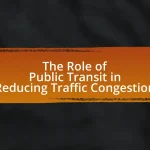Public transit plays a crucial role in shaping real estate markets by significantly increasing property values and demand in areas with accessible transit options. Properties located near public transit stations can appreciate by 10% to 30% compared to those further away, driven by enhanced accessibility and reduced transportation costs. The article explores how different types of public transit systems impact property values, the implications for urban planning and zoning laws, and the long-term effects on neighborhood revitalization and economic development. Additionally, it addresses the challenges developers face when integrating public transit into real estate projects and outlines best practices for investors to maximize returns on transit-oriented developments.

What is the Influence of Public Transit on Real Estate Markets?
Public transit significantly influences real estate markets by increasing property values and demand in areas with accessible transit options. Studies show that properties located near public transit stations can see value increases of 10% to 20% compared to those further away. For instance, a report by the American Public Transportation Association indicates that homes near public transit can sell for an average of $300,000 more than similar homes located farther away. This trend is driven by the convenience and reduced transportation costs associated with proximity to transit, making such locations more attractive to buyers and investors.
How does public transit impact real estate values?
Public transit significantly increases real estate values by enhancing accessibility and desirability of locations. Properties located near public transit stations often experience higher demand, leading to increased prices. A study by the National Association of Realtors found that homes within a half-mile of public transit stations can sell for 20% more than similar homes located further away. Additionally, areas with robust public transit systems tend to attract more businesses and residents, further driving up property values.
What factors contribute to the relationship between public transit and real estate prices?
Public transit accessibility significantly influences real estate prices by enhancing property desirability and reducing transportation costs. Properties located near transit stations often command higher prices due to the convenience and time savings associated with easy access to public transportation. A study by the Victoria Transport Policy Institute found that homes within a half-mile of public transit stations can see price increases of 10% to 20% compared to similar homes further away. Additionally, public transit can stimulate local economic development, leading to increased demand for housing in those areas, further driving up real estate prices.
How do different types of public transit systems affect property values?
Different types of public transit systems significantly affect property values, with proximity to transit stations generally leading to increased property values. For instance, properties located near heavy rail systems, such as subways, often see a value increase of 10% to 20% compared to those farther away, as evidenced by a study from the National Association of Realtors, which found that homes near transit stations sell for higher prices due to the convenience and accessibility they offer. Conversely, properties near bus transit systems may experience a more modest increase, typically around 5% to 10%, as bus services can be less reliable and less desirable than rail options. This correlation between transit accessibility and property values highlights the importance of transit type in real estate market dynamics.
Why is public transit considered a key factor in real estate development?
Public transit is considered a key factor in real estate development because it significantly enhances accessibility and connectivity, which in turn increases property values. Studies show that properties located near public transit stations can see value appreciation of 10% to 20% compared to those further away. Additionally, public transit attracts a diverse demographic, including commuters and young professionals, leading to higher demand for housing in transit-oriented areas. This demand is supported by data from the American Public Transportation Association, which indicates that areas with robust public transit systems experience faster economic growth and development.
What role does accessibility play in real estate market trends?
Accessibility significantly influences real estate market trends by affecting property values and demand. Areas with better access to public transit typically see higher property values, as they attract buyers seeking convenience and reduced commuting times. For instance, a study by the American Public Transportation Association found that homes located near public transit can sell for up to 20% more than similar homes farther away. This trend indicates that accessibility not only enhances the desirability of a location but also drives market dynamics, leading to increased investment in transit-oriented developments.
How does public transit influence urban planning and zoning laws?
Public transit significantly influences urban planning and zoning laws by promoting higher density development and mixed-use areas near transit stations. This is evident in cities like Portland, Oregon, where the establishment of light rail lines has led to zoning changes that encourage residential and commercial growth within a quarter-mile radius of transit stops. Such planning aims to reduce reliance on automobiles, enhance accessibility, and support sustainable urban growth. Additionally, studies show that areas with robust public transit options experience increased property values, which further drives local governments to adapt zoning regulations to facilitate transit-oriented development.
What are the long-term effects of public transit on real estate markets?
Public transit significantly enhances real estate markets by increasing property values and attracting investment. Studies show that properties located near transit stations can see value appreciation of 10% to 30% compared to those further away. For instance, a report by the American Public Transportation Association indicates that homes near public transit systems appreciate faster than those in car-dependent areas, leading to higher demand and rental prices. Additionally, improved accessibility fosters economic development, resulting in increased commercial activity and job creation, further boosting the attractiveness of nearby real estate.
How does public transit development affect neighborhood revitalization?
Public transit development significantly enhances neighborhood revitalization by increasing accessibility and attracting investment. Improved transit options lead to higher property values, as studies indicate that properties within a half-mile of transit stations can see value increases of 10% to 20%. Additionally, enhanced public transit fosters economic growth by facilitating easier access to jobs and services, which in turn encourages new businesses to establish in revitalized areas. For example, cities like Portland and San Francisco have experienced revitalization in neighborhoods following the introduction of light rail systems, demonstrating a clear correlation between transit development and neighborhood improvement.
What are the implications for future real estate investments near transit lines?
Future real estate investments near transit lines are likely to experience increased demand and higher property values. Proximity to public transit enhances accessibility, making properties more attractive to buyers and renters who prioritize convenience. Studies have shown that properties located within a quarter-mile of transit stations can see value increases of 10% to 20% compared to those further away. Additionally, urban planning trends favor transit-oriented development, which encourages mixed-use projects that integrate residential, commercial, and transit facilities, further driving investment opportunities. As cities continue to expand transit networks, the implications for real estate investments will include a shift towards higher density developments and a focus on sustainable living, aligning with demographic preferences for urban lifestyles.
How can real estate investors leverage public transit trends?
Real estate investors can leverage public transit trends by identifying properties located near transit hubs, as these areas typically experience increased demand and higher property values. Studies show that properties within a half-mile of public transit stations can see a price premium of 20% to 30% compared to similar properties further away. Additionally, investors can focus on emerging transit projects, as areas slated for new transit lines often see a surge in development and investment opportunities before the transit is operational. By analyzing transit ridership data and urban development plans, investors can make informed decisions that align with future growth patterns, maximizing their return on investment.
What challenges do developers face when integrating public transit into real estate projects?
Developers face several challenges when integrating public transit into real estate projects, including regulatory hurdles, funding limitations, and community opposition. Regulatory hurdles often arise from zoning laws and land use policies that may not align with transit-oriented development goals. Funding limitations can restrict the ability to invest in necessary infrastructure improvements, as public transit projects often require significant financial resources. Community opposition can stem from concerns about increased traffic, noise, and changes to neighborhood character, which can complicate project approval processes. These challenges can hinder the successful integration of public transit into real estate developments, impacting overall project viability and community acceptance.
What best practices should be followed when considering public transit in real estate investments?
When considering public transit in real estate investments, investors should prioritize proximity to transit stations, as properties located near public transit typically experience higher demand and increased property values. Research indicates that homes within a quarter-mile of transit stations can see property values increase by 10-20% compared to those further away. Additionally, investors should analyze transit accessibility and frequency, as areas with reliable and frequent service attract more residents and businesses. Understanding local transit plans and future developments is also crucial, as upcoming transit expansions can significantly enhance property values. Lastly, evaluating demographic trends in transit usage can provide insights into potential rental demand and investment viability.
How can investors assess the potential impact of new transit projects on property values?
Investors can assess the potential impact of new transit projects on property values by analyzing proximity to transit stations, historical data on property value changes following similar projects, and demographic shifts in the area. Proximity to transit stations often correlates with increased property demand, as studies show that properties within a half-mile of transit stations can see value increases of 10% to 20%. Historical data indicates that cities like San Francisco and Washington, D.C. experienced significant property value appreciation after transit expansions. Additionally, demographic shifts, such as an influx of residents seeking convenient transportation options, can further drive demand and influence property values positively.
What strategies can be employed to maximize returns on transit-oriented developments?
To maximize returns on transit-oriented developments, developers should focus on mixed-use designs, strategic partnerships, and effective marketing strategies. Mixed-use developments that combine residential, commercial, and recreational spaces attract a diverse range of tenants and customers, enhancing overall profitability. Strategic partnerships with local governments and transit authorities can facilitate funding and streamline approvals, reducing time to market and costs. Effective marketing strategies that highlight the benefits of proximity to public transit can increase demand and rental rates, as studies show properties near transit hubs often command higher prices, with a 20% premium reported in some urban areas.


